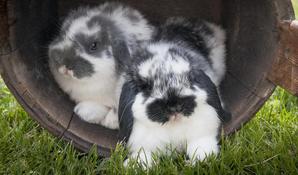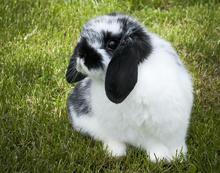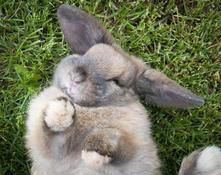Feathered & Furry Foto Farm
815-993-4320
Please call or text!!!
McNabb, Illinois
All About Holland Lops
You are thinking about buying a bunny...now is a Holland Lop right for you and your family? What do they eat? How do I house my bunny? There are many questions that should be considered when deciding on adding ANY pet to your home. Here is some information about Holland Lops and how to care for this great loving breed!
The Holland Lop is a breed recognized by the ARBA (American Rabbit Breeders Association). The Holland Lop is not a Miniature Lop. The American Mini Lop is a separate breed.
History of the Holland Lop
The original breeder of the Holland Lop was Adrain De Cock, his goal was to produce a miniature version of the French Lop. He started by breeding a white Netherland Dwarf doe to a French Lop buck, but did not get the litter he was expecting. He decided to switch the sexes in the breeds, breeding a French Lop doe to a Netherland Dwarf buck. The result,however, all had normal, erect ear carriage.
So in 1952, de Cock took a doe from the litter of six to breed to an English Lop buck. Producing five young of mixed ear carriage between lopped, erect and half-lopped. The loped doe was aggressive, so he bred the half-lopped doe to a buck from the first litter of six. In turn, the does from the original litter were bred with the bucks form the second litter. The resulting lopped bunnies were selected from the litter and interbred with an emphasis on French Lop characteristics.
De Cock soon had a group of Holland Lops weighting between 2.5 to 3 kilograms. By January 1964, he bred the Holland Lops to a more desirable weight of less than 2 kilograms and presented four rabbits to the Netherland Governing Rabbit Council,where the Holland Lop was recognized as a new breed.
ARBA Acceptance
Soon after, Aleck Brooks brought the breed to the United States in 1976 where they were now recognized by the ARBA in 1979.
Size
Hollands are a dwarf breed and are the smallest breed of lop-eared dwarf rabbits - they weigh between 2 and four pounds full grown.
The Holland lop is a short coupled rabbit. Its body length to head ratio should be 2:1. Other rabbits are 3:1. A Junior rabbit (under 6 months old) must not weigh less than 2 lbs to be shown. A Senior Rabbit (over 6 months old) must not weigh more than 4 lbs to be shown.
Shape
The Holland is to be heavily muscled, compact and well balanced in length, width and depth. The general shape of the body is short, massive and thick set.
The shoulders should be deep with depth carried back to the hindquarters and the chest should be broad and well filled. The width of the shoulders should be nearly equal to but not greater than the width of the hindquarters. The hindquarters should be broad, deep, well rounded and well filled at the lower portions.
A dewlap - small one - is permitted in does.
Ears
The ears of a Holland Lop are crucial for showing. The ARBA breed standard offers 42 points out of 100 points for Head, Ears and Crown combined.
A good ear,as defined by the ARBA is short and rounded at the tips. A good term to help create a mental image is "teaspoon shaped". The ear should also lay wide and open against the head.
A bad ear would be the opposite but also the ear should not be too long. The ear should not fall longer than one inch below the chin.
Colour
There are many different colour varieties of Holland Lop with are divided into eight groups:
1) Self: Black, Blue, Chocolate, Lilac, REW and BEW.
2) Shaded: Sable Point, Siamese Sable, Seal, Smoked Pearl, Black Tort, Blue Tort, Chocolate Tort and Lilac Tort0.
3) Agouti: Chestnut, Chocolate Agouti, Chincilla, Chocolate Chincilla, Lynx, Opal and Squirrel.
4) Tan Pattern: Black, Blue, Chocolate and Lilac Otters.
5) Wide Band: Cream, Fawn, Frosty, Orange, Red and Tri-Colours.
6) Pointed White: Black, Blue, Chocolate and Lilac Pointed Whites.
7) Ticked: Gold Tipped and Silver Tipped Steels in Black, Chocolate, Blue and Lilac.
8) Broken: Any color in conjunction with white.
Fur Type/Coat
The fur is to be glossy, dense, fine in texture and uniform in length. Fur should be approximately 1 inch in length and is to gradually roll back to normal position when stroked from the hindquarters to the shoulders.
Hollands should have a good coat, firmly set in the pelt. They should have firm flesh - neither too fat (soft and flabby) or too thin (bony.
Average Lifespan
On average Holland Lops live for up to 10 years.
Personality
As with all rabbits, they are individuals and therefore it is difficult to generalize them when talking about "personality". However, the majority of Holland Lops are known for their excellent temperament being more docile and gentle in comparison to other breeds.
They are very intelligent and easy to litter-box train. Hollands are a very popular breed as they make wonderful pets and are a perfect breed for young children. They are easy to handle and crave affection.
Does
Female Holland Lops are generally very sweet. They can get grumpy during their teenage state. They may grunt, however not all does are like this. Some of my favorite bunnies are does. They can be very devoted to their owner.
Bucks
Bucks can be very cuddly and generally do no go through a teenage cranky stage, however some bucks will spray if you have a doe around. Bucks in general make great pets as they do love attention and are almost dog-like in character.
Choosing between a buck and a doe is difficult for most people. The above references to bucks and does is generalized. I personally find that every bunny is an individual and can't be stereotyped. All of my babies are handled daily...and go to their new home friendly. The more attention the babies get, the friendlier they are and the more they love their owners. The more the bunnies get out to let out energy and play - the better pets they make and the friendlier they remain.
Holland Lops can be extremely pricey because they are one of the more difficult breeds to raise. Sometimes they can be very hard to find and when you do find them they usually sell pretty fast.
These wonderful rabbits are full of life, very active and very social. The short coat makes them easy to care for and they are small so they do not eat much or take up much space.
FF Foto Farm Rabbitry and Aviary
Mini Nubian and Nigerian Goats for Sale in Illinois
Holland Lops for Sale in Illinois
Netherland Dwarfs for Sale in Illinois
Rabbits for sale in Illinois
Swans for sale in Illinois
Peafowl for sale in Illinois
Located in McNabb, Illinois
815-993-4320
fffotofarm@gmail.com






